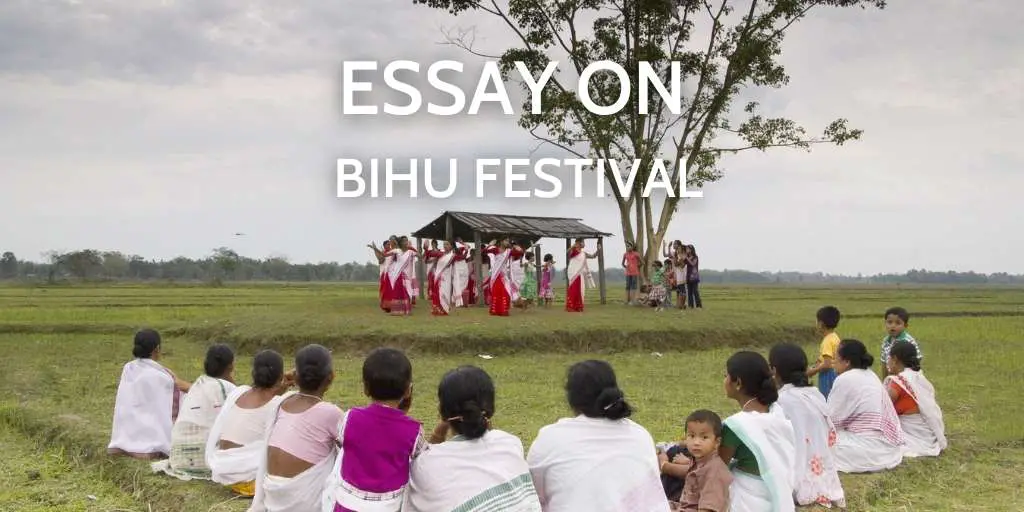In this article, read essay on bihu festival for students and children in 1000 words. This article includes its date, importance, history, and celebration of Bihu.
Essay on Bihu festival for Students and Children in 1000 Words
Lohri, Pongal, and Bihu festivals are celebrated around Sankranti and are all local forms of the solstice. Bihu is the major harvesting festival in Assam. They celebrate this harvest festival in the joy of ripening.
Date of Celebration of Bihu
India is a country of festivals, on which distinct types of ethnic groups together freely follow their rituals. Bihu festival celebration date: 14th April 2021 to 16th April 2021.
Importance of Bihu Festival
Bihu is the biggest festival celebrated in Assam. Assamese people celebrate it every year with great love and enthusiasm.
Like all festivals, the Bihu festival is celebrated by following its ancient rites and practices New Year in April. In Assam, the atmosphere of happiness and joy is overshadowed by joy. Bihu is one of the unique festivals in Assam.
Here, people of Assam offer the first crop of the season to their god Shibari so that his house is always full of grains. It is a festival celebrated in the joy of harvesting crops. Apart from Assam, it is also celebrated in Odisha, Punjab, Nepal, Tamil Nadu, and Kerala. On this day, it is customary to bathe and wear new clothes.
The word Bihu derives from the language of the Dimasa sect. Dimasa has been an agrarian community of ancient times. This community has been the worshiper of one of its clans, named Shibari.
Here, the first crop is harvested in April since India is an agricultural country. We see all the festivals celebrated moving around from agriculture and prosperity.
Bihu is also one celebration associated with agriculture, which is celebrated in different provinces of India under different names. In Bihu, these crops are dedicated to the Shibari deity, and people wish that this light by his grace and May prosperity and happiness prevails in the houses and fields.
According to the ancient civilization, Bihu is a profanity language derived from Bishu, ‘Bi’ meaning to ask and ‘Shu’ means to the peace and prosperity of earth.
History of Bihu Festival
What is the meaning of Bihu?
The word Bihu is from the language of the Dimasa people. ‘Bi’ means ‘ask’, and ‘shu’ means ‘peace and prosperity’ on the earth. This Bishu itself deteriorated into Bihu. According to others, ‘b’ means ‘ask’ and ‘hu’ means ‘give.’ People celebrate Bihu thrice in a year.
They celebrate the first in winter on Paush Sankranti, the second on the day of Equinox Sankranti and the third in Kartik month. Pausha month or Sankranti is celebrated as Bhogali Bihu, Equinox Sankranti in Rongali Bihu, and Kartik month in Kongali Bihu.
People celebrate Bihu festival three times a year. Apart from the month of April, they also celebrate Bihu in October in the name of Kongli Bihu. They also celebrate Bihu is in January, which is known as Bhogali Bihu. We consider it as the basis of the beliefs related to all three Bihu agriculture, that from the root rule, Bihu is an agricultural festival that the farmer wants to fulfil his desire for his good harvest.
On the occasion of Bihu, huge big fairs are organized in Assam, in which people of Assam and Bahar also take part in it, and they are happy that similar big festivals are organized every year.
The following are: – People of Ambubachi fair, Parashuram fair, Dol Jatra fair, Ashokashtami fair in these melas wear traditional clothes, and perform traditional dances. Using the fact that the Vadyntra Traditionally Vadyntra such as – Dhol, Tal, Pepa (a bugle instrument made of Bains horn), Toca, Bahi (flute), Kshatul and Gogona, etc.
Why is Bihu called Bhogali?
Bhogali Bihu falls on or around Paush Sankranti during the Makar Sankranti festival. It is called Bhogali because it has the importance of enjoyment. That is, during this time, people consume food with pomp, and a variety of food items are prepared and fed.
Celebration of Bihu Festival
The new year of Assam begins from the month of Baisakh. They celebrate this festival with different customs. We also know it is also as Bohag Bihu. They worship the cow on the first day of Bihu. They take him to the river in the morning and bathed. They use raw turmeric and Kalai dal for bathing.
Smoke from medicinal plants is used to drive mosquito-fly around them. There is a new rope to tie the cows. On this day people eat curd-chivda during the day. Assamese people organize all kinds of programs in the joy of this new year.
They eat vegetables with green leaves along with the dishes. In Bihu, people perform Bihu dance, which is a traditional dance here. The dance of women and men dancing on the beat of the dhol, flute, papa, rhythm is from centuries.
Uruka is the first day of Magh Bihu. On this day, people make a temporary camp with paddy straw in an open space called Bhelaghar. By putting four bamboos near this cantonment, they build a tall dome-like straw and wood on it, which is called Meiji. All the people in the village have dinner here.
On the second day of Uruka, Bihu is launched by taking a bath and burning Meiji. All the people of the village gather around this Meiji and wish God to Mars. To fulfill their desires, people also offer various things in Meiji.
People also perform folk dances to express their happiness during the Bihu festival. They make a range of dishes like Coconut Laddu, Sesame Peetha, Ghila Peetha, Machhi Pitika, and Bengena Khar, other traditional dishes.
I hope you will like this Essay on Bihu Festival for Students. Please share your thoughts via comments. Thanks for reading.
